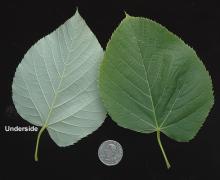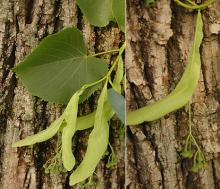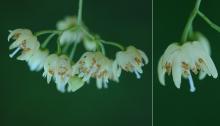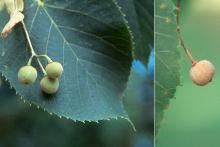Tilia americana
Common name:
American Linden
American Basswood
Pronunciation:
TIL-i-a a-mer-i-KA-na
Family:
Tiliaceae
Genus:
Type:
Broadleaf
Native to (or naturalized in) Oregon:
No
- Deciduous tree, 60-80 ft (18-24 m), pyramidal when young, when mature lower branches droop down but tips ascend; rounded form. Bark gray-brown, many long, narrow flat topped ridges. Leaves alternate, simple, 12-15 cm long, thick, tip abruptly acuminate, base cordate or truncate, margin coarsely serrate with long pointed teeth, glossy to dull dark green above, lighter below, 3-5 veins arising at the base, tufts of hair in axils of lateral veins; petiole 2.5-7.5 cm long. Flowers pale yellow, 11-13 mm across, appear after leaves fully expanded, 5-10(15) per cluster, floral bract is 7-10 cm long. Globose fruit, 8-12 mm across, without ridges, covered with gray-brown pubescence.
- Sun to part shade. Best in deep, moist, fertile soil, but tolerates drier, heavier soils
- Hardy to USDA Zone 3b Native range covers much of eastern North America; from New Brunswick and Maine west to southern Quebec, Ontario, Michigan, Minnesota, and Manitoba; south to eastern North Dakota, Nebraska, Kansas, Oklahoma; east to northern Arkansas, Tennessee, western North Carolina, and New Jersey.
- Tilia heterophylla [White Basswood] has leaves with densely whitish pubescence on the underside but otherwise very similar to Tilia americana and now it is included in T. americana.
-
Several cultivars, including:
- American Sentry® (‘McKSentry’) – straight, well-formed, narrow pyramidal canopy, narrower that the species, 60 ft tall and 25 ft wide (18 × 13 m)
- 'Boulevard' - tall, narrow, and very straight-growing, ascending branches, very hardy (USDA Zone 3), well suited to street plantings
- 'Continental Appeal' - tree, to 50 ft tall (~15 m), dense crown, ascending branches. Leaves large, 9-15 cm long and 7-10 cm wide, dark green above, whitish pubescence below. Once considered a Tilia heterophylla.
- Legend® (DTR 123’) – broadly pyramidal shape, fast growing, 40 ft tall and a spread of 30 ft (12 × 9 m), clean glossy green leaves, resists rust problems of the species
- 'Redmond’ – probably of hybrid origin, some consider it a cross of T. americana × T. ×euchlora, shorter, denser and more compact than the species, 40 ft tall and 20 ft wide (12 × 6 m), long proven in years of urban use, reliable as a street tree, hardy to USDA Zone 3
- Corvallis: southwest corner 4th St. and Tyler Ave.
- Oregon State University campus: NE Kearney Hall, along Monroe Ave.
Click image to enlarge

















